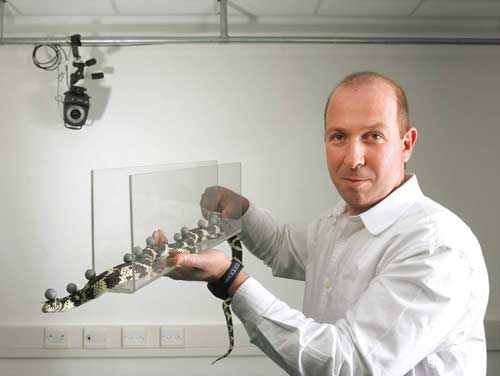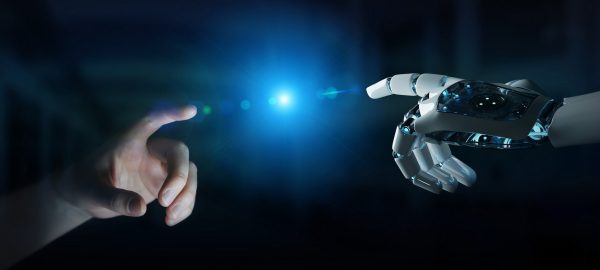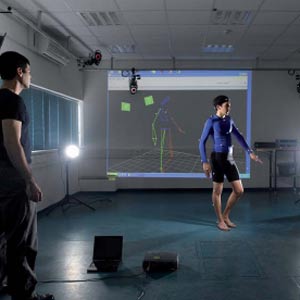נחשים, רובוטים ובני אדם שצועדים בנעליים מוזרות הם מקצת מהאובייקטים שהמעבדה לביו-מכניקה וביו-רובוטיקה של פרופ'/ח אלון וולף חוקרת את אופן התנועה שלהם
מאת נעם ברקוביץ

פרופ'/ח אלון וולף עם אחד מהנחשים במעבדה
המעבדה לביו-מכניקה וביו-רובוטיקה של פרופ'/ח אלון וולף בפקולטה להנדסת מכונות היא בין המעבדות הצעירות בטכניון, עם זאת בשלוש שנות פעילותה מאז הוקמה ב-2006, הספיקה לצבור מגוון רחב ומרשים של מחקרים המשלבים שורה של תחומים – ביו-מכניקה, קינמטיקה, ארגומטריה, רובוטיקה, אלגוריתמיקה ועוד. צילומי ניסויים הנערכים במעבדה בהם נראים בני אדם או נחשים שמוצמדים אליהם חיישני תנועה הפכו לחלק מהדימויים החזותיים המתקשרים לטכניון.
מחקר שיכול להעיד על הגיוון בתחומי העיסוק ושיתופי הפעולה הוא ניסוי המתנהל לאחרונה בו נבדקת האלסטיות של התבניות המוטוריות במוח בתגובה לשימוש בנעליים מיוחדות. אופן ההליכה, מסביר פרופ'/ח וולף, הוא תכונה שנרכשת בשלב מוקדם של ההתפתחות שלנו והיא צרובה במוח כתבנית, כמו כל תבנית הנרכשת בהתנסות מוטורית כמו שחיה, רכיבה על אופניים וכו'. כאשר מתעוררת בעיה אורטופדית במפרק, למשל, עקב שחיקה, היא נוטה להחריף משום שהחולה ממשיך להפעיל באופן בלתי רצוני את אותה תבנית מוטורית, וכתוצאה מכך את אותם הכוחות שתרמו מלכתחילה לבעיה. רעיון ייחודי של חברת אפוס היה לפתח נעליים מיוחדות שייצרו באופן מכוון הפרעה ביציבות ויאלצו את החולה לאזן את עצמו מחדש באופן מתאים יותר לבעיה שנוצרה. בסדרת ניסויים שנערכו במעבדה בטכניון הוכיחו החוקרים כי החולים מאמצים לעצמם כתוצאה מההפרעה המכוונת הילוך שונה, כלומר תבנית מוטורית חדשה לגמרי, המקטינה את העומסים הגורמים לבעיה.
פרופ'/ח וולף: "במחקר רואים שעל-ידי יצירת הפרעה מכוונת, המערכת העצבית ומערכת השרירים מגיבות ופועלות לתיקון המצב כפי שאנו רוצים שיהיה. בחינה של הקינמטיקה, קינטיקה והאותות החשמליים של השרירים, מראים שאנשים שהולכים עם הנעליים הללו 3-6 חודשים , כחצי שעה ביום, פשוט לומדים ללכת מחדש, גם בנעלים רגילות או יחפים, באופן המתאים למצבם האנטומי העכשווי. זו גישה מקורית שמביאה בשורה חדשה לאורטופדיה. המחלה לא נרפאת אבל נבלמת. החולה לומד לשתף פעולה עם הבעיה ודוחה בשנים את הצורך בניתוח כמו החלפת ירך או החלפת ברך".
פרופ'/ח וולף מעורב בפרויקטים נוספים בתחום הרפואי בעיקר ברובוטים רפואיים. חלק מהפרויקטים הם בתוך הפקולטה ופרויקטים אחרים, כמו רובוט נחש זעיר לניתוחי לב, החלו עוד בתקופת עבודתו כחוקר במרכז לרובוטיקה של אוניברסיטת קרנגי מלון בארה"ב. הרעיון והמימוש לבקרת התנועה של אותו רובוט הם של פרופ'/ח וולף בשיתוף עמיתיו האמריקאיים פרופ' האווי צ'וסט ופרופ' מרקו זנאטי, ומאמר שלהם בנושא זכה לפרס במאמר הטוב ביותר בכנס שלIEEE – המכון האמריקאי להנדסת אלקטרוניקה וחשמל, שנערך ב-2006.
תחום רחב נוסף בו עוסקת המעבדה הוא רובוטים למטרות חילוץ והצלה. המחקר והפיתוח מתנהלים על פי מודל אמריקאי שגובש לאחר הפיגוע במגדלי התאומים – CRASAR. האתגר הטכנולוגי ברובוטים כאלו הוא מגוון ביותר. הרובוטים צריכים להיכנס לאתרי אסון מבלי לגרום לתזוזות כלשהן במבנים שיגרמו להתמוטטות נוספת, הם חייבים לנוע בתוך סדקים וחללים צרים, לשאת אמצעי חישה ואיתור סימני חיים, לשאת מקור כוח והנעה לעצמם, ומעל הכל הם חייבים לנהל את ההתקדמות שלהם בתוך סביבה מסובכת לתנועה ורצופת מכשולים.
תחום שפרופ'/ח וולף מתמחה בו בהקשר הזה הוא רובוטים נחשיים, או בשפה המקצועית רובוטים בעלי מכניזם עם יתירות גבוהה – Hyper redundant hybrid mechanism. הרובוטים מורכבים מכמה יחידות משורשרות שבקרת התנועה שלהן מבוזרת בין כל היחידות, ממש כמו שמתקיימת מערכת בקרת תנועה בבעלי חיים בטבע. גם אצל בעלי חיים לא כל הפקודות מגיעות מהמוח, וחלקן מתבצעות ברמה המקומית בחוט השדרה.
במעבדה בטכניון מנתחים פרופ'/ח וולף ועמיתיו את תנועתם של נחשים אמיתיים כדי ללמוד דרכים להנעת רובוטים. "בפעם הראשונה שהחזקתי נחש ביד וצפיתי באופן שהוא נע, הבנתי פתאום איזו דרך ארוכה עוד יש לנו כדי להגיע לתחכום של הטבע", אומר פרופ'/ח וולף. "הוא חזק ונע באופן חלק ומתוחכם. רק מהתבוננות בו אתה יכול ללמוד איך לשפר את הרובוטים אותם אנו בונים".
דוגמה לפיתוח שנולד מתוך התבוננות כזו הוא טכנולוגיה של תנועה בתוך צינור. החוקרים במעבדה הכניסו את הנחש לתעלה צרה והבחינו שבאין מרווח מספיק להפעיל את פיתול הגוף הרגיל שלו הנחש מפעיל איסטרטגיה שונה כדי להתקדם. הוא מחלק את גופו למספר אזורים שכל אחד פועל כמו קונצרטינה. כאשר חלק אחד נדחף בכוח לדפנות הצינור ומייצר עוגן לכל הגוף החלקים האחרים מתכווצים ומתארכים בהתאם ומניעים את הנחש קדימה. סטודנטים של פרופ'/ח וולף פיתחו על פי התובנה הזו רובוט המסוגל לנוע בתוך צינור. הפרויקט זכה בפרס שני בתחרות פרויקטים כלל טכניונית. ברשימה למטה קישורים לסרטים בהם נראה הנחש נע בתוך תעלה והרובוט שפותח על פי איסטרטגיית התנועה של הנחש נע בתוך צינור.







